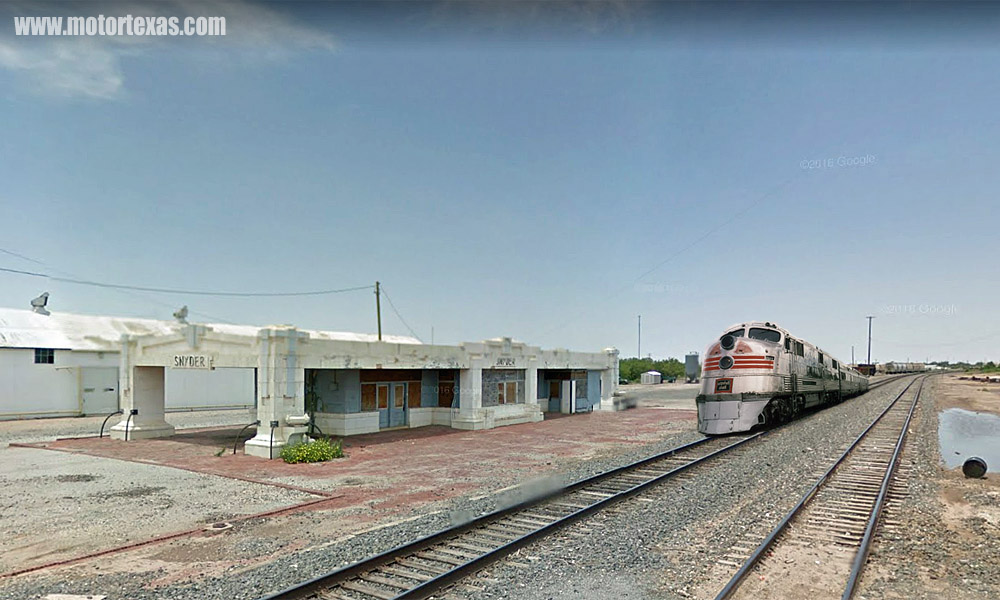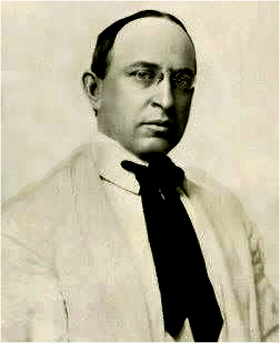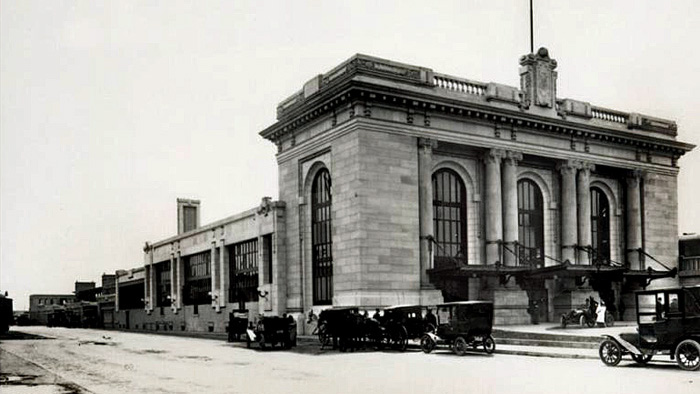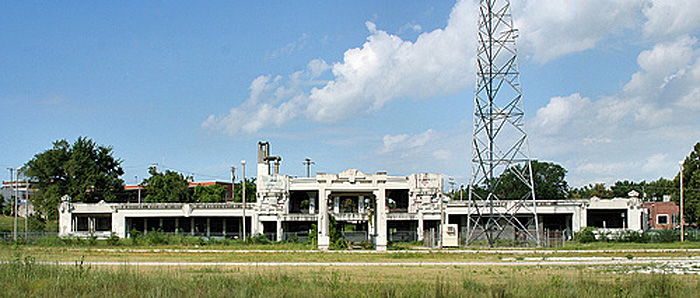The Amazing (but Sad) History of the Snyder Texas Train Depot
By: James Wilder

Screen shot image via Google Streetview. Zephyr train added for fun.
The Synder Train Depot, a rare and historic treasure, was scheduled to be demolished in October 2016. As for the outcome, we'll talk about that later.
While most train depot buildings are relatively plain wooden structures, presumably, designed to be easily recognized as train depots, the design of the Snyder depot is architecturally unique, in visual style, and materials used.
Back in the early 1900s, the Santa Fe Railroad needed a few depots along a route between Sweetwater and Lubbock. They commissioned architect Louis Curtiss, of Kansas City, Missouri, to build four depots. The depots were built in the towns of Lubbock, Post, Snyder and Sweetwater, between 1909 and 1911. The Snyder depot was built in 1911.
Out of the four depots, two were lost. The Lubbock depot was destroyed by fire and the Sweetwater depot was demolished.
Thankfully, the depot in Post survived, and was restored in 2011. It is now used as a chamber of commerce office.
So, why should the Snyder depot be spared destruction? If it was designed by Frank Lloyd Wright, would we still destroy it? As it turns out, architect Louis Curtiss was a contemporary of Frank Lloyd Wright, and was on his way to gaining national recognition for his unique architectural style.
Who Was Louis Curtiss?

If you've never heard of Louis Curtiss, you're not alone. Although I saw one of his train stations in Wichita Kansas a few years ago, I didn't know anything about this architect until researching the Snyder depot.
Several Louis Curtiss biographies are available online, so I will keep this one brief.
Louis Singleton Curtiss was born on July 1, 1865, in Belleville, Ontario, Canada.
His parents died when he was 19 years old.
He studied architecture at the University of Toronto and the Ecole des Beaux-Arts in Paris.
Curtiss moved to Kansas City, Missouri, in 1887.
He started his career as a draftsman and later formed a partnership with Frederick C. Gunn and founded the Gunn and Curtiss firm.
It was during his partnership with Gunn that they designed the Tarrant County Courthouse in Fort Worth. The courthouse was completed in 1895. It barely escaped being demolished in 1958. The courthouse has since gone through several restoration projects in 1983, 2012 and 2015.
Curtiss eventually started his own architectural firm in 1899.
He designed a wide variety of buildings during his career, one of the most famous being the Boley Clothing Company Building (1909), Kansas City, Missouri. This building was one of the first glass curtain-wall structures in the world.
During his 37 year career Curtiss designed government buildings, railroad stations, restaurants, hotels, and residences. He designed over 200 buildings, but some structures were never build, and many have been destroyed. Today, more than 30 buildings still stand, mostly located in the Kansas City area.
It is reported that Curtiss was a bit eccentric, dressed in all-white outfits, was a motorcar enthusiast, was president of the local Automobile Club, drove recklessly (ah, to the casual observer, skillful might be seen as reckless. We'll never know), and chain-smoked custom-designed cigarettes.
There is very little known about the man except for newspaper accounts and the physical evidence of his buildings. He never married, had no siblings and never gave interviews to the press.
Louis Curtiss died on June 24, 1924, in Kansas City, Missouri, at his drafting table. He was buried in an unmarked grave, on his request, at Mount Washington Cemetery, Independence, Missouri.
Louis Curtiss was described as "the Frank Lloyd Wright of Kansas City" by Trudy Faulkner, a preservationist with the American Institute of Architects.
Certainly, it Curtiss had lived as long as Wright, his fame would have been much greater.
His architectural works have had a significant and lasting impact, and many of the buildings and homes he designed are on the National Register of Historic Places.
Louis Curtiss Train Stations
Louis Curtiss designed several train stations for the Atchison, Topeka and Santa Fe Railway. Four are still standing.
In addition to the depots in Post and Snyder, there are two significantly larger structures you will certainly appreciate.

Union Station, Wichita, Kansas
Union Station, in Wichita, Kansas, was completed in 1914. The design of this building is described as Beaux Arts. Its clean design is strikingly majestic. It has six Greek style columns in the front. The columns serve to anchor three massive iron overhangs, that cover the three entrances. The building was made of reinforced concrete and white Colorado stone was used for its veneer. It was recently renovated and now serves as an office building. The site also contains a renovated train depot.

The bones of Union Depot, Joplin, Missouri
The Joplin Union Depot, in Joplin, Missouri, was completed in 1911. This depot is similar in design to the Snyder depot, except it's about five times larger. It is on the national register of Historic Places, but it is completely unrestored, vacant and covered with graffiti.
Seeing that only four Curtiss designed train stations exist adds even more weight to the importance of saving the Snyder depot, for current and future generations to enjoy.
Destiny of the Snyder Depot
The Snyder train depot is over a hundred years old, has a unique design, and is an important artifact of Texas transportation history. Those are solid facts that make this building special.
But the real value in this depot is its architect, Louis Singleton Curtiss.
So, what's the status of the Snyder Depot?
The demolition was stopped, thanks to a rally on October 10, 2016, organized by local preservationists.
However, neither the story, nor the depot, ends here.
Sometime after the rally, an individual from Austin intervened and offered to buy the building, if it could be transported.
As a reminder, this is not a wood, or brick building; it's cast, reinforced concrete. Cutting this thing up would be quite an engineering exercise. As well hauling it, as reassembling it.
Hopes were high. Engineers were brought in. Calculations were made. But the numbers didn't look good.
On October 2, 2017, the Scurry County Historical Commission released a statement which contained the bad news - "EVERY avenue had been exhausted and the depot is once again on the Burlington Northern Santa Fe (BNSF) Demolition list...There is no definite time table of demolition, other than it is imminent."
So, if you are a fan of architecture and history, plan your trip quickly to view the historic Snyder train depot, designed by Louis Singleton Curtiss, "the Frank Lloyd Wright of Kansas City."
Location
Snyder, Texas is located about 85 miles southeast of Lubbock, and has a population of 11,572 residents as of 2016.
Snyder Depot
954 College Ave, Snyder, TX 79549
goo.gl/maps/wdwtZPREaty
Final Update. RIP
When Snyder, Texas couldn't come up with a way to move the depot (an impossible task), the BNSF wasted no time in scheduling it's destruction.
The demolition started Nov. 6, 2017. The depot was tough to destroy, but by Nov. 14, the historic building was gone.
The only remnants were nearly 17,000 bricks surrounding the depot, the depot’s sign featuring the town’s name and the Santa Fe railroad insignia, and the large urn-like planters that surrounded the building at the corners.